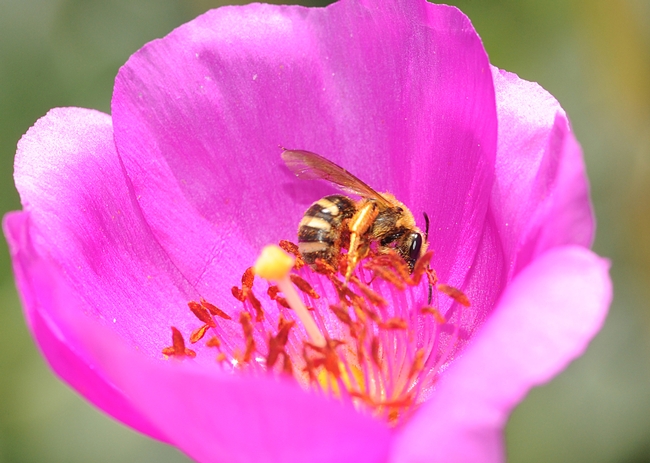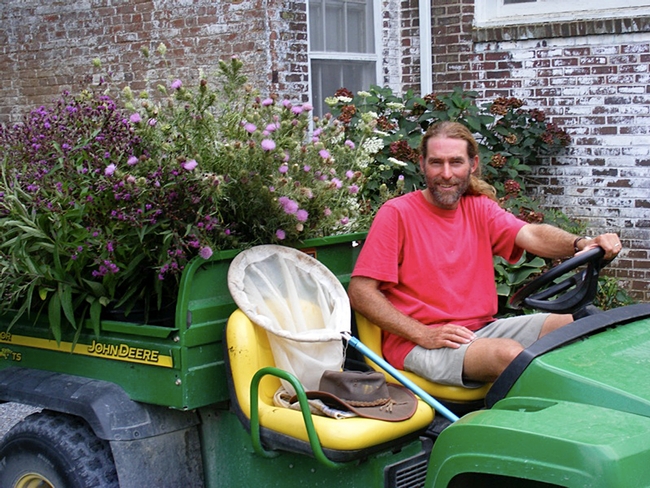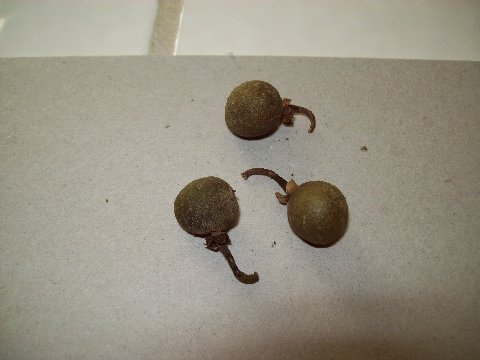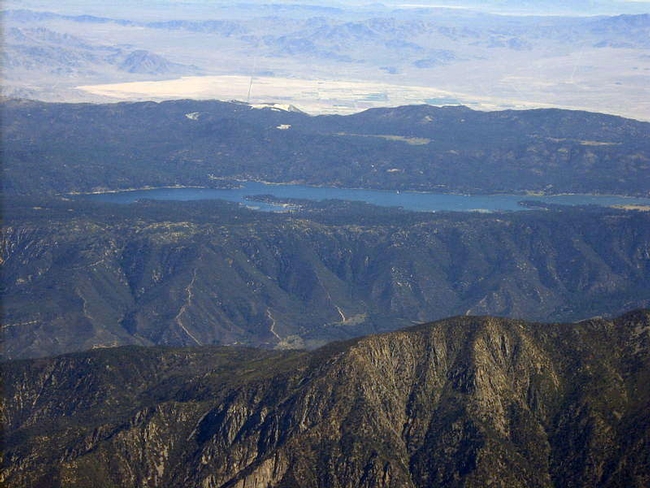UC Blogs
So You Want to Cut a Tree Down?
This blog is for all you “Paul (and Paulette) Bunyans” out there who want to cut something down; specifically, a tree with a chain saw. We’ve all seen people (usually men) operating chain saws with wood chips flying around, shrub or tree becoming a smaller and rather tidy pile of wood and brush. Ever wonder if you too could accomplish this job? Earn bragging rights: “Oh, by the way, I cut down that old tree in the backyard this morning and have a supply of wood for the fireplace, ready to go!” Or did you figure to save the money you’d pay a tree service? You can, but you need the basics first. I run chainsaws in the course of my job, and there is no safer way to operate one of these machines, electric or gas-powered than by knowing the basics and following them every time. Let’s start out with some basics:
The first thing to do before even looking at a chainsaw is to prepare for the task. This means having the correct protective gear or items. Personal Protective Equipment (or PPEs) is your first line of safety when work with machinery.
In this case, a hard hat (helmet) will protect your head from falling limbs or branches. The best helmets will also have a face guard. But, you say, I’m not going to have limbs and branches falling; a helmet will also protect your face from branch/limb tips that may rake across your face while working and prevent large pieces of material from poking you around the eye area.
The next PPE would be safety glasses or goggles; these prevent smaller pieces of debris from your eyes as well. If you wear glasses, use goggles; these are designed to fit snuggly over glasses so that your eyes are totally protected.
Ear muffs or ear plugs will protect your ears from permanent injury from the noise generated by chainsaws. Noise from some gas-powered chain saws can exceed 100 decibels. A hard hat that includes ear muff and a face shield is the best PPE chainsaw work. For the hands, lightweight gloves which fit snuggly, preferably leather will protect your hand from cuts, scratches, and scrapes.
Always wear trim-fitting clothing with, buttoned sleeves; no rings, watches, or jewelry. Loose clothing can snag easily on branches, debris or even the chainsaw itself!
Wear chainsaw chaps to protect your legs from saw kickback. These chaps are made of ballistic nylon fibers that, when cut, clog the chain saw and stop it from cutting any deeper. A side note: I have a pair of chaps at home that have a 10 gash in them at the thigh area. This occurred when I used my thigh to balance a chainsaw when cutting. I’ve never done that again!!!
Last PPE item is good-fitting leather work boots with a minimum of 6” high tops and steel toes to protect your feet.
Remember to know First Aid, especially for severe bleeding, 2nd degree burns (the muffler can get extremely hot), and that all persons in the area know where the First Aid kit is. Please also remember that running a chainsaw is not a 1-person show; even professionals also have 2 people in the area just in case there is an accident.
Now that you are dressed for the occasion, let’s go on and prepare the saw. I’m assuming at this point that you have read the instruction booklets that came with your saw which deal with familiarizing yourself with the operation and care of the chainsaw. Please don’t skip this important step –remember that a chainsaw is not a toy or something to fool around with; treat is as you would treat any piece of machinery, with care and respect!
Make sure that the chain is sharp and tensioned properly. Your operator’s manual will have this information. A chain that is too loose can derail (throw) and can whip back at you; a chain that is too tight will bind and wear out prematurely. Make sure that your saw is clean, with a clean air filter, good spark plug, and have an effective muffler. All the skill in the world will not overcome a dirty, not fully functioning chainsaw. Make sure that it is full of gas and chain saw before staring out. If using an electric saw, make sure that you have a long enough extension cord which is compatible with the amperage of the saw.
Before starting the engine, set the saw on a firm surface in an open arena free of debris or combustible material. Make sure the chain brake is engaged (this stops the blade until you release it). Maintain good balance and have secure footing. Grip the handlebar firmly with the left hand and press down to keep the saw from moving around once it starts. With your right hand, pull out the starter cord until there is a definite resistance and give a brisk, strong pull.
When operating the saw, always hold the chainsaw firmly with both hands; wrap your fingers and thumbs around the handles. Grip the front handle with your left hand and the rear handle with your right hand, even if you are left-handed like me. With your hands in this position, you can best oppose and absorb the push, pull, and kickback forces of the saw without losing control. Keep proper footing and balance at all times. Never use a chainsaw with only one hand!
Finally a list of chainsaw “don’ts”:
When operating a chainsaw, never do the following:
- Work alone
- Work on a ladder or any other insecure support
- Hold the saw above shoulder height
- Overreach to make a cut
- Work in a tree
- Put pressure on the saw when reaching the end of a cut (the pressure may cause the bar and rotating chain to pop out of the cut, go out of control and strike you or some other object.)
- Work at night or in dim light
- Allow other people in the general work area, even when starting the saw
- Operate the saw indoor or in poorly ventilated conditions
- Use the saw to pry or shovel away limbs, roots, or other object
- Refuel a hot saw
- “drop start” a saw as you may drop it after it is started and running
Yes, the above list seems a little on the “Duh!!” side, however, remember that this list exists because someone has done all of these things.
A chainsaw, much like other motorized machinery, can help make a job faster and easier –But only when used properly!
What Governs the Quality of Pollen?
If you're interested in pollen and pollinators, you'll want to attend the UC Davis Department of Entomology seminar at 12:10 p.m., Wednesday, Feb. 1...

Female sweat bee in the genus Lasioglossum, on a rock purslane. (Photo by Kathy Keatley Garvey)

T'ai Roulston at State Arboretum of Virginia.
Winter Vegetable Gardening
I absolutely love having a winter vegetable garden--wonderfully easy to grow greens such a great variety of lettuces, kale, cabbage, and broccoli. I and my new puppy, Katie, go out early each morning and pick fresh veggies for my husband's green smoothie, as well as clipped leaves for his take-to-work salad. I greet the day, she attacks the borecole (kale) with delightful vigor, and my husband eats very well.
I start my plants from seed inside the garage in the fall under a grow light using small pots. These same seeds could be started indoors under a window that gets bright sun most of the day. When the plants are 4-5 inches tall, I begin to harden them off (leaving them outside for several hours each day for about a week, enabling them to adjust to the outdoors). Then out into my raised beds they go. As the plants are young and fresh, I make sure I use snail bait*, as I am not willing to share.
One of the primary benefits I have always touted is the absents of needing to water a winter garden. We can actually go away in our RV and not worry about the soil drying out and the garden dying--UNTIL THIS YEAR! Oh my, where is winter? I just does not seem fair. Mother Nature does not play by the rules. She makes them up as she goes along. Therefore, Katie and I now need to spend time watering instead of chasing balls and we have had to postpone her first RV trip. Additionally I must remember to cover the raised beds at night when temperatures are predicted to drop below freezing. Old sheets work well for this task.
The weather report seems to never change, and I have found myself cringing when I hear someone talk about what a beautiful day it is today-- again. Winter! Please get here before spring.
*note: use the snail bait with Iron Phosphate as the active ingredient as it is safe around pets and children. Baits with Metaldehyde are very poisonous and should be avoided!

Winter vegetables. (photo by Cheryl Potts)
Camellia sinensis
My Camellia sinensis, the tea camellia, is the only camellia I have blooming now. Camellia sinensis is used for drinking tea and is the plant that all commercial tea, except herbal tea, comes from. This year because of our strange weather it did not have as many blossoms as it has in the previous years and bloomed earlier than usual.
My plant is about 6 years old and is a slow grower. You have to look for the flowers among the leaves because the flowers are only less than one inch in diameter, but they do have an fragrance to them. The other day I was picking off the spent blossoms and I found four seed pods on it. Unfortunately, it looks like the frost might have gotten to them. I have decided to try and see if I can get the seed pods to grow, but from the information I found on doing this the process for germination, which involves a clear jar, sphagnum moss, and a warm dark place. If they are going to sprout it can take up to two weeks, but because my seeds are not fresh the information says it can take longer. There is an even longer process once they sprout before they are ready to be planted outside in the soil. But I'll let you know if I am successful at having them sprout!

Camellia seed pods. (photos by Betty Victor)
Nearby open space raises the value of homes
The closer homes are to open spaces – parks, stream and river corridors, forests and other natural lands – the higher the value of the homes in Riverside and San Bernardino counties. However, if homes are far from such open land, homebuyers tend to place an especially high value on lot size.
These were some of the findings of research, which graduate student Monobina Mukherjee at UC Riverside conducted in collaboration with Linda Fernandez, a former associate professor in the UC Riverside Department of Environmental Sciences. A summary of this research is in the September-October 2011 issue of UPDATE, a newsletter published by the Giannini Foundation of Agricultural Economics.
Open space provides a broad range of benefits to communities – such as rural vistas, wildlife habitat and relief from urban congestion – which go beyond the benefits of the land to its owners. In conducting this research, Mukherjee and Fernandez sought to analyze how a policy of land conservation and wildlife habitat preservation influences the housing market.
Mukherjee and Fernandez's study was focused on San Bernardino and Riverside counties. Riverside implemented the Riverside County Integrated Project in 1999 to support conservation of open space and wildlife habitat. San Bernardino County has abundant open space, including wildland in national and state forests. The researchers designated study zones and used statistical analysis to determine the impact of open space and other variables on residential sale value.
“Larger yards sometimes seem to act as a substitute for public open space,” Mukherjee said. "I can see why this happens because these two counties experienced less dense, bigger parcel sales for period of time we have been analyzing."
In Riverside County, a 10 percent increase in the distance from the nearest park is associated with a small but statistically significant decrease in the sale price of the property, the study found. The same was true in San Bernardino County with respect to both wildland and city parks. The results showed that scarcity of open space in areas with big cities could lead homeowners to place even higher value on proximity to open space.
Mukherjee and Fernandez found the amenity values generated in this study could help public policymakers estimate the monetary benefits of open space and habitat conservation. The results can also be used for land-use planning and conservation decisions in Riverside and San Bernardino counties plus other regions with similar geographical characteristics and residential markets.

Open space in San Bernardino County, including Big Bear Lake and Lucerne Dry Lake. (Photo: Wikimedia Commons)

